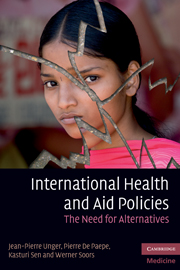Book contents
- Frontmatter
- Contents
- Preface
- Biographies
- Notices
- Acknowledgements
- List of abbreviations
- Reviews
- Introduction: Overview and purpose
- Section 1 Paradigms of international policies
- 1 Donor led policies: analysis of an underlying doctrine
- 2 The Achilles heel of international health policies in low- and middle-income countries
- Section 2 The failure of the aid paradigm: poor disease control in developing countries
- Section 3 Impact of international health policies on access to health in middle-income countries: some experiences from Latin America
- Section 4 Determinants and implications of new liberal health policies: the case of India, China and Lebanon
- Section 5 Principles for alternative, publicly oriented health care policies, planning, management and delivery
- Section 6 A public health, strategic toolkit to implement these alternatives
- Conclusions
- Glossary
- Index
- References
1 - Donor led policies: analysis of an underlying doctrine
Published online by Cambridge University Press: 06 December 2010
- Frontmatter
- Contents
- Preface
- Biographies
- Notices
- Acknowledgements
- List of abbreviations
- Reviews
- Introduction: Overview and purpose
- Section 1 Paradigms of international policies
- 1 Donor led policies: analysis of an underlying doctrine
- 2 The Achilles heel of international health policies in low- and middle-income countries
- Section 2 The failure of the aid paradigm: poor disease control in developing countries
- Section 3 Impact of international health policies on access to health in middle-income countries: some experiences from Latin America
- Section 4 Determinants and implications of new liberal health policies: the case of India, China and Lebanon
- Section 5 Principles for alternative, publicly oriented health care policies, planning, management and delivery
- Section 6 A public health, strategic toolkit to implement these alternatives
- Conclusions
- Glossary
- Index
- References
Summary
Chapter 1 contains material previously published in:
De Paepe P., Soors W., Unger J. -P. International Aid Policy: Public Disease Control and Private Curative Care? Cadernos de Saude Publica 2007; 23(Suppl. 2): S273–281.
Introduction
Many authors advocate integrating vertical programmes into local health facilities in order to achieve reasonable prospects for successful disease control (Bossyns, 1997; Loretti, 1989; Oxfam, 2003; Tulloch, 1999). An editorial in the influential New England Journal of Medicine (Mulholland & Adegbola, 2005) on bacterial infections (as a major cause of death among children in Africa), for example, stressed the need for comprehensive, integrated and accessible health services to address health needs and questioned the narrow, disease-based approach that has prevailed to date.
Whilst there is a need for some non-integrated vertical programmes in most countries (Criel et al., 1997), any health policy allocating public health activities and disease-control programmes to Ministry of Health (MoH) structures and general health care to private facilities remains highly problematic since it precludes the integration of disease control with general health care.
Through a review of multilateral aid policies, this chapter examines whether current international aid policies have supported the allocation of health care and disease control to different health facilities rather than integrating them into one. In other words this section will focus on outlining the doctrines informing policy rather than describing their implementation, which will be addressed in later sections. The actual implementation may differ due to specific political, social, geo-strategic, and economic factors.
- Type
- Chapter
- Information
- International Health and Aid PoliciesThe Need for Alternatives, pp. 3 - 15Publisher: Cambridge University PressPrint publication year: 2010
References
- 1
- Cited by



